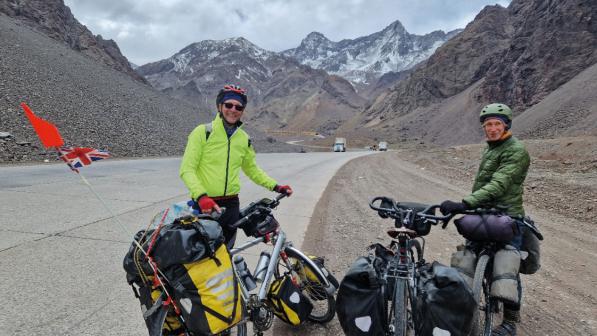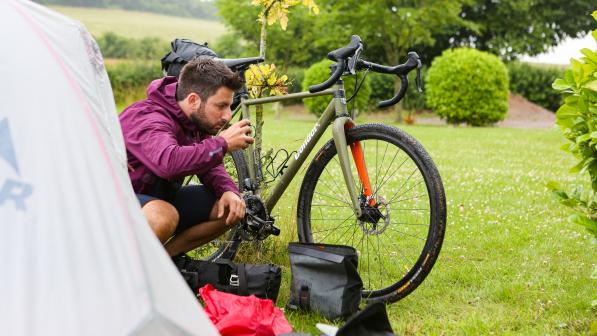Great Rides: The Camino de Santiago

Karen Darke: by handcycle
Since becoming paralysed from the chest down, Paralympic champion and adventurer, Karen Darke has handbiked through the Himalayas, skied across Greenland, and climbed El Capitan. She won Paralympic Gold in Rio in 2016.
Modern-day pilgrims queued at an old door into an office, collecting passports and stamps to endorse their journey. They were travelling on well-worn trails from St-Jean-Piedde-Port in the French Pyrenees to the ancient Spanish city of Santiago de Compostela. I watched the scene, the Camino’s symbolic shell jangling from rucksacks and painted on the wall.
Twelve days and around 1,100km of French roads had led us to the heart of the Camino. Since our start in Brittany, days had rolled by on a conveyer belt of forest, lakes, waves, and campsites that blurred into a fragmented movie. Where had we watched the sun sink and burst amber across the foaming Atlantic surf? When had the wind blown so strong it felt the tent would collapse? Which was the night with barking dogs?
Seeing other Way-goers brought a sense of excitement. An artery of purpose lay ahead. We would follow the Camino Francés across the mountains to Spain. The laid-back position of handcycling gave me views of the peaks, of lovely raw rock, of trees stretching tall into the expansive blue sky. Despite the grind of climbing long hills, I enjoyed it more than the flat riding of the French coast. The twists and turns held surprises, the tops revealed dramatic panoramas, the descents whisked in fresh inspiration.

The Camino wanders between pretty villages with old stone churches and shuttered houses with colourful window boxes, alive with invitations to sample the menu of the day. The walking path – also good for mountain biking – is often at the roadside or twists through adjacent fields. We exchanged calls of “Buen Camino”. I wondered: Why did they walk? What was their story? The rhythmic circles of pedalling lulled me into a moving meditation. Busy towns were a shock, and the pulsating heartbeat and heaving streets of Pamplona purged away peaceful contemplation.
‘My Way’ was not a retreat but a sleep-deprived journey with an evolving bunch of rowdy, snoring men, and I welcomed the company of my quieter 15-year-old nephew in the final week of brutally cold, damp Galician mountains. Despite that, The Way brought change for me: subtle, exciting, unruminated shifts that are still unfolding.
There is no finer way to take a journey than to share it with others and be welcomed by loved ones at the end. Waiting at the paving stone that marks kilometre zero, in the centre of the indescribably beautiful plaza beneath the cathedral of Santiago, we were greeted with hugs and dry clothes.

Karen's Journey:
Distance: 2,000km. 65-120km/day for 25 days, plus four days off.
Route: L'HôpitalCamfrout (near Brest, Brittany) to Bayonne. Inland to St Jean-Piedde-Port, then along the Camino Francés.
Conditions: Windy and wet in France. Sunny and warm (20- 30ºC) from Bayonne to Burgos. Cold (0-15ºC) across northern Spain. Wet in Galicia.
Accommodation: Camping/campervan as far as Burgos, then Camino hostels.
Bike used: Carbonbike handbike
Maps/guides: Garmin and Google Maps
I’m glad I had… Full waterproofs, gloves, and hat for Galicia. Sleeveless jersey for the hot part.
Next time I would… Set off earlier – not at the end of September.
Matt Mallinder: brothers on bikes
Cycling UK's director of influence & engagement was a cycle racer, and now enjoys ticking off sportives. He’s a convert to cycle touring, loving the mix of cycling, local cuisine, new countries, and stunning scenery.
It’s five in the afternoon and the heat is finally fading. My hot shoes are kicked off, salt crystals wiped from the brow, and I’ve just taken the first refreshing glug of ice-cold cerveza that is the perfect reward for the hard but satisfying route that’s brought me here.
We’ve just finished day three, the middle day of our Camino Portugués, and find ourselves in a beautiful square with palms and tiled houses in the walled citadel in Valença. We’re overlooking the Rio Minho valley – the geographical barrier and physical border between Portugal and Spain. The bridge taking us on to Tui and our night’s accommodation is half in Spain and half in Portugal.
Our 350km Camino on 29er mountain bikes is from Porto in Portugal to Santiago de Compostela, following the Caminho Real Central route and then the Camino Finisterre from Santiago to the Atlantic coast. The route, originally for walkers, is now becoming popular with cyclists but, unlike the crowded Camino Francés, it’s easy to go miles without seeing other peregrinos.

The riding would be easier with lightweight bikepacking kit than panniers, as some paths are steep and rough. It's a mix of quiet roads, sandy farm tracks, and cobbled footpaths all signposted with tell-tale yellow arrows. Follow them and your route unravels through vineyards, cornfields, eucalyptus forests, and pine woodlands. The scent is reminiscent of a Radox bath, and the heat and pummeling cobbles make me want to soak in one.
The leg from Ponte de Lima to Tui is the shortest of our trip at 45km, but it includes a gruelling 3km climb to the 400m peak of Alto de Portela Grande. Bottom gear was invented for this. The start is easy, meandering along dried riverbeds where dragonflies dart, and alongside cornfields bordered by vines and wildflowers. Then it kicks up. A cobbled climb becomes a boulder track. Then a forestry worker points us onto a roughly surfaced lane, which takes us to the top. The 10km descent to our sealevel destination is exhilarating.
I’m riding with my twin brother Ben. Our routine is established: 20km to the first café stop and the first stamp in our pilgrim’s passport (three stamps a day earns you a certificate at the end); 15km on to the lunch stop for a fixed €10 lunch of ‘something with patatas’; and then the slow grind of the last 15km to the day’s destination for a cold beer and pinchos: an amuse-bouche of Cerano ham on bread, patatas bravas, or Spanish tortilla. It’s a reason to move from bar to bar, and to look forward to where the journey will take us tomorrow.

Matt's journey:
Distance: 350km, 40- 70km per day
Route: From Porto up the west coast of Portugal via Tui, sharp left at Santiago, then 90km over two days to Cap Finistèrre.
Conditions: Temperatures in September were around 35ºC. There were some forest fires. Route was mostly offroad tracks and lanes.
Accommodation: Variety of hotels. A twin room was typically €60.
Bikes used: Rented 29er MTBs with panniers, tools, and helmets.
Maps/guides: John Brierley’s Camino Portugués map book.
I’m glad I had… Lightweight, loose-fit, sweat-wicking tops.
Next time I would… Take a GPS – and a better sense of humour for the hard bits.
Further info: bikeiberia.com
Alex Cuppleditch: an engaging trip
Cycling UK's head of Volunteering, Alex is currently working towards the ambitious mission of enabling a million more people to cycle by supporting and empowering our wonderful Cycling UK volunteer network.
My partner Tom and I wanted an adventure in the sun with no route planning. One of the Caminos looked perfect: well-known, well-used trails that are way-marked with yellow arrows. Like Matt and his brother, we picked the Camino Portugués.
In my opinion, it’s the best Camino to do by bike, although it throws up some challenges for cyclists. On one of the main climbs, we had to carry our bikes on our backs because it was so rocky and steep. The other pilgrims (on foot) looked at us like we had lost our minds. But it was worth it for the downhill afterwards, even though it was lumpy and my bike lacked suspension.
For the most part, however, the Camino is more forgiving. Much of the trail is on tarmac and smooth paths through pine woods. There is also a fair amount of cobbled streets and gravel tracks to keep it interesting.

We hardly encountered anyone on the route until the last two days as we approached Santiago de Compostela. The people we did meet were so friendly and couldn’t do enough for us, including giving us food. Most pilgrims are walkers rather than cyclists, so you don’t have an opportunity to gather trail companions. But although our encounters were fleeting, they were memorable.
The last day turned out to be the longest, wettest, and most challenging. We set off in the early hours, in the pitch black and rain. It didn’t dampen our mood since we knew we were going to complete our tour. As we reached the city of Santiago, the energy of all the excited pilgrims was tangible. The route was packed; we even started to encounter cyclists arriving from other Caminos.
Bagpipes serenaded our arrival into the busy square. I impatiently demanded Tom get off his bike to take a picture of us with the cathedral in the background. He seemed more interested in finding his headphones, and I started to get cross with him. Then he bent over and went down on one knee, producing a ring and asking me to marry him. I never saw that coming!
Everyone around us went wild and I did too. I am not sure who made more noise, me screaming or the crowd cheering. It’s a trip I’ll never forget. I will relish telling the grandkids!

Alex's journey:
Distance: We averaged 35 miles per day over five days.
Route: Porto to Santiago de Compostela.
Conditions: In September, the weather was warm but not too hot. It hammered down on the last day. Most of the route was off-road paths and gravel tracks.
Accommodation: A mixture of camping, Airbnb, and hotels.
Bikes used: Tom – Trek 8500 MTB. Alex – Surly Long Haul Trucker.
Maps/guides: Pilgrim’s Guide to the Camino Portugués.
I'm glad I had… An engagement ring at the end! Also good to have were: a Rab Microlight Alpine jacket; padded shorts; a travel towel.
Next time I would… Not fly. I’d cycle to Lisbon, start there, then ride home from Santiago.














